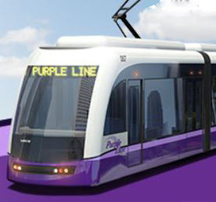State & Feds Must Chip In for Hogan's Maglev,
Say Japanese
Press release issued June 8, 2015
State and federal taxpayers will have to support Governor Larry Hogan's proposed $10 billion-plus maglev train, Japanese news sources report. This contradicts assurances given the Baltimore Sun by the governor's spokesman that “the administration isn't proposing an expensive new spending project financed by taxpayers.”
The financing for the maglev would use the same model as Maryland plans for the Purple Line light rail, with state and federal money passed on to a private company that builds and operates the line. The state is exploring similar setups for the Red Line light rail in Baltimore.
The reports come from two of Japan's most respected and reliable news organizations, Nikkei Asian Review, the English-language version of Japan’s leading financial newspaper (Nihon Keizai Shimbun), and Asahi Shimbun, often described as the New York Times of Japan.
A Japanese government source told Nikkei Asian Review that a maglev deal would require what the paper describes as “support from the U.S. federal and state governments.” The Asahi Shimbun report says that Japan will loan money “if the U.S. government acquires” the trains and quotes a senior official of Japan Central Railways: “There will be no progress without the U.S. government’s actual decision to construct maglev lines.”
“Experience with maglev and high-speed rail proposals in the U.S. over the last 25 years proves that nothing but studies happen until the states step up to the plate financially,” commented Nick Brand, Action Committee for Transit president.
“The only new high-speed rail project actually under construction is in California,” he added. “That state's voters passed a $9 billion bond measure in 2008, and the governor and legislature recently agreed to devote a quarter of annual revenues from a new greenhouse gas cap and trade program to match federal and private funding. Maglev in Maryland would likely require billions in State capital funding, an order of magnitude bigger than the commitment needed for the Purple or Red lines.”

